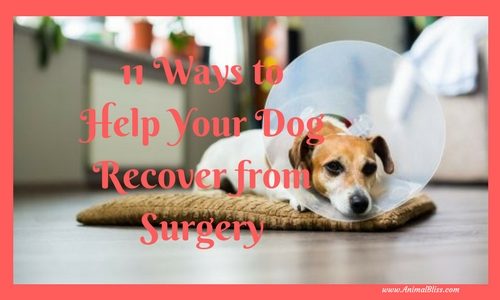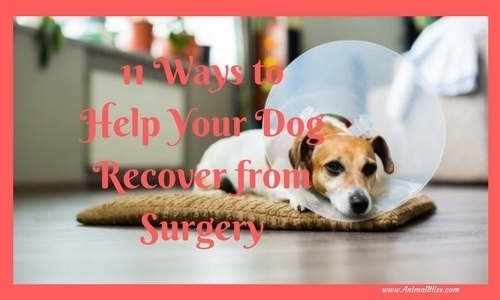Ways to Help Your Dog Recover from Surgery
Even if it’s just getting spayed or neutered, your dog will probably have surgery at some point in his or her life. No dog owner likes to think about their pup having surgery, but don’t dread the thought: the procedure can save your dog’s life, or help him live it to the fullest.

However, surgery is only the first step in the process. Your dog will need to recover from the procedure, and that’s where you come in. Dog owners play a huge role in ensuring a safe, speedy recovery for their canine companions. If your pooch has an upcoming surgery, follow the guidelines below for 11 ways to help your dog recover from surgery to help him stay comfortable and heal faster.
1. Talk to your Vet Before you Leave
Seeing your pup all groggy after surgery can be distressing, and it’s natural to want to move him to the comforts of home as soon as possible. But before leaving the animal hospital, talk to your vet about treatment protocols and what you should and shouldn’t do. Discussing recovery in person will allow you to ask clarifying questions and clear up confusions immediately, which will only lead to better care for your dog in the long run.
Be sure to review any medication schedules and behaviors or activities your dog should avoid. If you can, take notes (we suggest trying a pet medical record app), so you can refer back to them later; this way, you won’t feel pressured to remember everything in the moment.
2. Let your Pup Sleep off the Effects of the Anesthesia
Monitoring your dog for signs of unusual behavior is crucial, but don’t freak out if he seems really out of it for the first 12-24 hours after surgery. Most dogs will be quite lethargic, and they’ll just want to sleep off the experience. Don’t prod your dog awake, and give him a chance to rest deeply and recover naturally.
Dogs may briefly lose their appetite after surgery. Leave out small portions of easy-to-digest food but don’t force him to eat.
Anesthesia can also affect motor control, making it difficult for your canine companion to stand up straight, so set him up with a comfortable bed on the floor level (even if he usually sleeps on your bed or the couch). If the grogginess persists for several days, call your vet to check in.
3. Keep Your Dog Hydrated
Your dog will likely be nauseous after the surgery, and may even vomit, making it all the more important to ensure he stays hydrated. Keep a clean bowl of water within easy reach. Monitor it to make certain he has enough fluids and hasn’t knocked the bowl over.
Since anesthesia makes your dog groggy, check in on him to make sure he doesn’t fall asleep with his nose in the water, as he could drown (although the chances of this happening are pretty small). Don’t force your dog to drink excessive quantities of water, especially if it’s directly post-op, as this can stress his stomach and cause him to get sick.
RELATED:
Reasons Why You Should NEVER Declaw Your Cat
4. Restrict Your Dog’s Activity
After a couple of days of recovery, your dog may seem ready and raring to go, but this doesn’t mean that the wound site has healed enough for activity. If your dog’s surgery involved stitches, usually only minimal activity is advisable, such as walking outside to go to the bathroom (although dogs might need to go more often than usual post-op, so be aware of that).
Jogs around the block, jumping on furniture, and other energetic activities is usually a bad idea, as it can pull out the stitches and reopen the wound, causing everything from a bad scar to complications and infection. Ask your vet to determine the best course of action post-surgery. Dogs get cabin fever quickly, so it’s up to you to make the right decision for them, and hold them to it!
5. Don’t Ignore Your Dog’s Need for Play
Just because a dog can’t go on a walk doesn’t mean he should be deprived of stimulating play altogether. If your dog is up for a little playtime, give him a distraction that’s engaging over the long-term, such as a satisfying dog chew or a difficult-to-destroy dog toy. Such activities don’t require a lot of movement, but they can fend off doggie boredom for hours, distracting pups from their confinement.
6. Don’t Let Your Dog Irritate the Wound
Exercise isn’t the only culprit here — chewing and licking can also aggravate the wound and cause infections. This behavior can introduce infection or pull the stitches loose, neither of which is a good thing! If your dog is a compulsive licker or chewer, you might need to look into getting the infamous “cone of shame” (formally known as an “Elizabethan collar”), or an alternative like the inflated “donut” pillow or a neck brace. If your dog is distressed by wearing something around his neck, talk to your vet about other options that can also deter wound irritation.
RELATED:
Pet Stairs and Ramps for Injured Pets and Senior Dogs
7. Keep Him Away From Other Animals if Possible
Other animal friends, especially other dogs, can tussle with your post-op pooch and unintentionally reopen the wound. Even non-strenuous activities like licking the wound out of curiosity can introduce bacteria that cause infections. The same goes for children, or even adult guests who like to encourage dogs to play (the re-opening the wound part, not the licking part; I hope your human visitors aren’t licking your dog!).
It’s okay if guests are content to quietly pet your pup, but if your human visitors are prone to excite your canine companion — or your dog always loses his mind around them — keep your dog apart from guests until they’re cleared to play again.
8. Stick to the Medication Schedule
Some dogs gobble up medication like it’s a treat, others turn up their noses. Whatever your dog’s situation, follow your vet’s prescribed regimen for antibiotics and painkillers. If your pooch is reluctant to take medication, ask your vet for approved bribes, such as peanut butter. After all, a spoonful of sugar (metaphorically speaking) makes the medicine go down. However, be careful if you’re experimenting with home remedies; as always, your vet can advise you on the best course of action.
9. Don’t Over-Indulge With too Many Treats
Speaking of treating your pup, try not to overload them with treat delights following the surgery. Of course, you want to lavish your love even more than usual on your post-op pup, but too many treats can irritate his stomach, just as they would if he hadn’t had the surgery. The last thing your dog needs after his operation is more tummy trouble, so treat him in moderate quantities.
Stick with treats that Fido has tried before so you know that: 1) your dog will gobble them up, and 2) the treats won’t cause upset stomachs. Finally, don’t force your dog to eat treats if he doesn’t seem interested, especially right after the surgery.
10. Care for the Surgical Incision
Just as each dog is unique, each incision is unique, and therefore, so is each post-op care regimen. Some wounds should be left free to breathe, while others should be covered with a bandage or protected with a plastic bag when you take him on a potty walk outside, for example. Most surgery wounds don’t require regular cleaning, but you might have to rinse the incision site if it gets dirty or crusty. Your vet should tell you what to do, but don’t be overzealous when it comes to sterilization. Too-frequent cleaning can disturb the wound and keep the skin from knitting together.
11. Return to the Vet as Needed
Depending on the procedure your pup may only need a few days to recover, or the process might last much longer. Some dogs have to be confined for weeks or months after more intensive surgery, such as an orthopedic procedure. You may also need to return to the vet for follow-up appointments, which can include removing sutures, checking on a cast, running an X-ray, or physical therapy sessions. A long recovery can be tough for both you and your dog, but the more attentive you are, the faster your pup will be back to his tail-wagging self!
Conclusion
The surgery process doesn’t stop when your beloved dog leaves the pet hospital. The recovery component is almost as critical as the surgery itself, and conscientious care post-op can help your pup accelerate his return to his usual self. Like humans, dogs are vulnerable to complications post-surgery, but following these guidelines will significantly reduce the chance of post-op problems. Use common sense, and your beloved dog will be better in no time.
~~~~~
“11 Ways to Help Your Dog Recover from Surgery”
Guest Author: Jordan Smith
*** Please Share ***
11 Ways to Help Your Dog Recover from Surgery Share on X![]()
MY QUESTION FOR YOU:
Has your dog (or cat) had surgery recently?
*** Leave your comment below. ***
(It’s just sexy!)

Peace
DISCLOSURE: Animal Bliss is a participant in the Amazon Services LLC Associates Program, an affiliate advertising program designed to provide a means for us to earn fees by linking to Amazon.com and affiliated sites.
(In other words, we’ll get a very small (teeny tiny) commission from purchases made through links on this website.)
So, go on … Don’t be shy!
Buy Something BIG and Expensive!
Thank you!
😀
[amazon_link asins=’B015TSDUWC,B01GBYU6DE,B01MQTMF7W,B01M9I7NGK,B01MRUZUCV,B000XY5DSM’ template=’ProductCarousel’ store=’animblis-20′ marketplace=’US’ link_id=’c5f2567b-2a00-11e8-b6e8-b515ec856225′]
😀
- Mindful Travel With Your Dog This Holiday Season - December 23, 2019
- A-Z of Australia’s Endangered Wildlife - December 20, 2019
- Teaching Your Kids How to Walk the Dog Safely - December 2, 2019


Wow you of course did not owe anyone an update after what you’ve been through but I’m so glad you and your family are all okay!